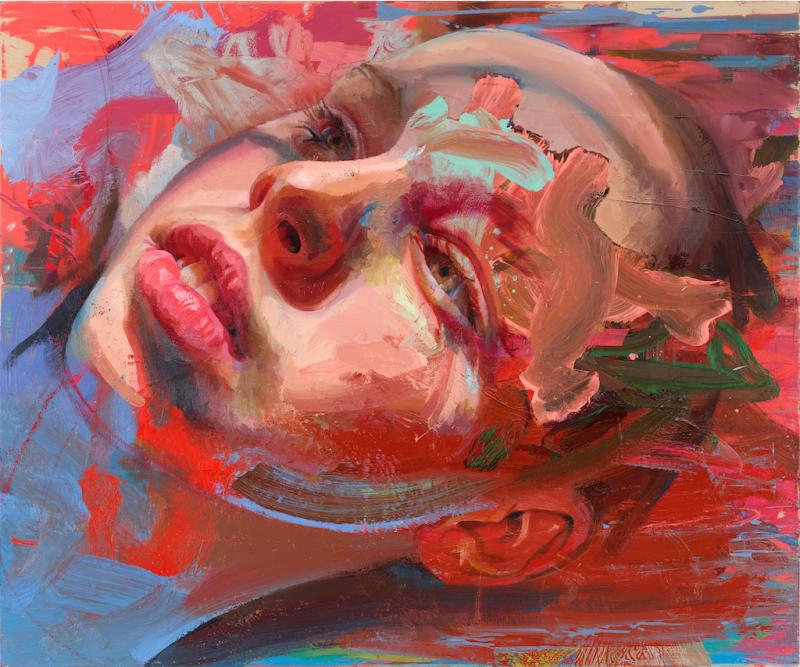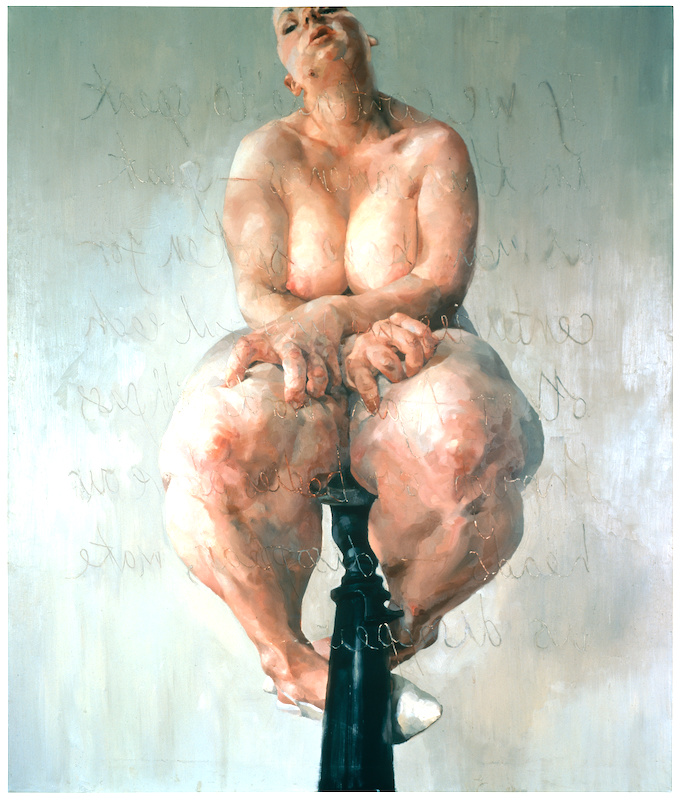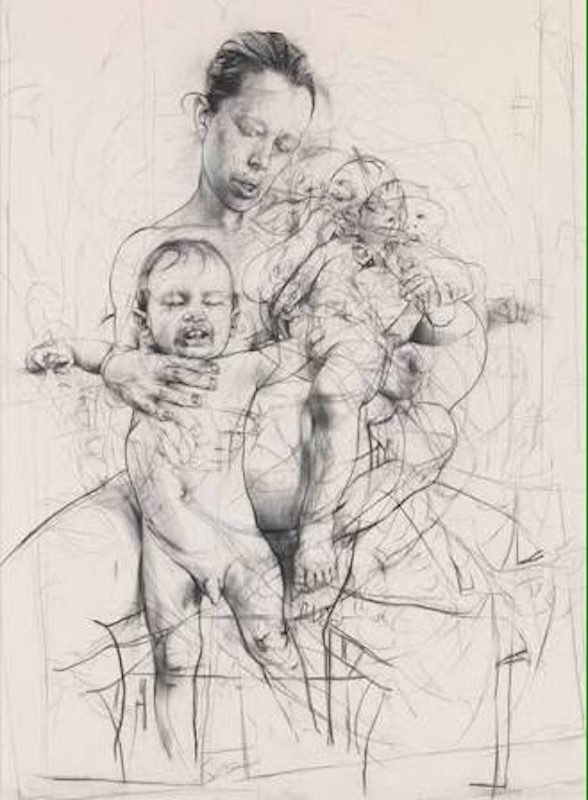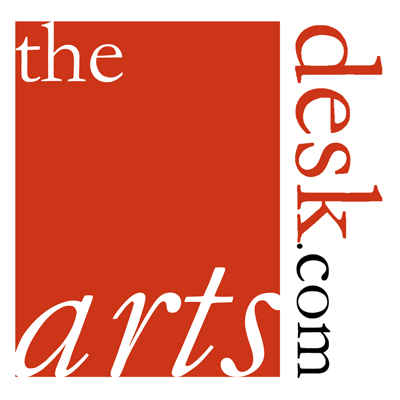Jenny Saville: The Anatomy of Painting, National Portrait Gallery review - a protégé losing her way | reviews, news & interviews
Jenny Saville: The Anatomy of Painting, National Portrait Gallery review - a protégé losing her way
Jenny Saville: The Anatomy of Painting, National Portrait Gallery review - a protégé losing her way
A brilliant painter in search of a worthwhile subject

When in the 1990s, Jenny Saville’s peers shunned painting in favour of alternative media such as photography, video and installations, the artist stuck to her guns and, unapologetically, worked on canvases as large as seven feet tall.
This enormous painting confronts you on entry to her retrospective at the National Portrait Gallery, and it is still a knock out. Perching awkwardly on a tiny pedestal is a mountainous woman. Her hands claw at her thighs as though trying to tear away the voluminous flesh. From her elevated position, she defiantly stares us down and also, as it were, the illustrious history of the female nude – all those beauties who, over the centuries, have offered their bodies for our delectation.
Scrawled into the paint in mirror writing is a quote from feminist author Luce Irigaray: “if we continue to speak in this sameness, speak as men have spoken for centuries, we will fail each other again”. Clearly, Saville is not speaking (painting) like a man.
 This wondrous nude challenges the cannon in several ways – by showing extreme discomfort under our gaze and also daring to look back and, self-evidently, by not conforming to traditional standards of beauty. Presented to us as a thinking subject rather than a desirable object, she exemplifies the anguish of inhabiting a body that is not considered attractive.
This wondrous nude challenges the cannon in several ways – by showing extreme discomfort under our gaze and also daring to look back and, self-evidently, by not conforming to traditional standards of beauty. Presented to us as a thinking subject rather than a desirable object, she exemplifies the anguish of inhabiting a body that is not considered attractive.
Although the subject may not be regarded as beautiful, Saville’s paint work is to die for. While still at college, she had already mastered the depiction of flesh in oils. More than 30 years later, though, Propped is still her best painting. She was blown off course in 1977, I would say, by a visit to the studio of the late Willem de Kooning.
She was inspired by the freedom of his paint handling and his drive towards abstraction. It gave her the impetus to loosen her own brushwork and introduce abstract elements in an attempt to create some tension by disrupting the figurative image. “That’s a powerful space to work in,” she says, “between those two elements (the abstract and figurative). If I can get that right, it feels good, and it’s worth the journey.”
I don’t see her getting it right, though. Whereas in Propped the figure is built from coherent brushmarks with the tension coming from the confrontational subject matter itself; in paintings like Drift, 2020-2022 (main picture), the image of the head is constructed in one language and loose brush marks are sloshed over and around it in another. The result feels schizophrenic; instead of a dialogue, there’s merely confusion.
 Her drawings of another traditional subject – mother and child – are wonderful, on the other hand. Inspiration came from old masters such as Leonardo da Vinci and Raphael, but instead of showing the Madonna in an idealised state of serene passivity, Saville portrays motherhood from actual experience – as hard work. In one self portrait she balances her young son on the mound of her pregnant belly while, in another, (pictured left) the boy’s image is multiplied to become an armful of restless, squirming vitality which she is struggling to contain.
Her drawings of another traditional subject – mother and child – are wonderful, on the other hand. Inspiration came from old masters such as Leonardo da Vinci and Raphael, but instead of showing the Madonna in an idealised state of serene passivity, Saville portrays motherhood from actual experience – as hard work. In one self portrait she balances her young son on the mound of her pregnant belly while, in another, (pictured left) the boy’s image is multiplied to become an armful of restless, squirming vitality which she is struggling to contain.
A real challenge would be to continue her exploration of motherhood by tackling a subject that is even more taboo than the pregnant body – childbirth. A friend took photographs of the artist as she was giving birth. A painting based on one of those images would make as important a contribution to the subject as Propped did to the genre of the female nude.
Paula Rego gave us memorable depictions of abortion; childbirth is another subject waiting to be tackled. I hope Jenny Saville takes up the gauntlet.
- Jenny Saville: the Anatomy of Painting is at the National Portrait Gallery until 7 September
- More visual arts reviews on theartsdesk
rating
Share this article
The future of Arts Journalism
You can stop theartsdesk.com closing!
We urgently need financing to survive. Our fundraising drive has thus far raised £49,000 but we need to reach £100,000 or we will be forced to close. Please contribute here: https://gofund.me/c3f6033d
And if you can forward this information to anyone who might assist, we’d be grateful.

Subscribe to theartsdesk.com
Thank you for continuing to read our work on theartsdesk.com. For unlimited access to every article in its entirety, including our archive of more than 15,000 pieces, we're asking for £5 per month or £40 per year. We feel it's a very good deal, and hope you do too.
To take a subscription now simply click here.
And if you're looking for that extra gift for a friend or family member, why not treat them to a theartsdesk.com gift subscription?
more Visual arts
 'We are bowled over!' Thank you for your messages of love and support
Much-appreciated words of commendation from readers and the cultural community
'We are bowled over!' Thank you for your messages of love and support
Much-appreciated words of commendation from readers and the cultural community
 Folkestone Triennial 2025 - landscape, seascape, art lovers' escape
Locally rooted festival brings home many but not all global concerns
Folkestone Triennial 2025 - landscape, seascape, art lovers' escape
Locally rooted festival brings home many but not all global concerns
 Sir Brian Clarke (1953-2025) - a personal tribute
Remembering an artist with a gift for the transcendent
Sir Brian Clarke (1953-2025) - a personal tribute
Remembering an artist with a gift for the transcendent
 Emily Kam Kngwarray, Tate Modern review - glimpses of another world
Pictures that are an affirmation of belonging
Emily Kam Kngwarray, Tate Modern review - glimpses of another world
Pictures that are an affirmation of belonging
 Kiefer / Van Gogh, Royal Academy review - a pairing of opposites
Small scale intensity meets large scale melodrama
Kiefer / Van Gogh, Royal Academy review - a pairing of opposites
Small scale intensity meets large scale melodrama
 Jenny Saville: The Anatomy of Painting, National Portrait Gallery review - a protégé losing her way
A brilliant painter in search of a worthwhile subject
Jenny Saville: The Anatomy of Painting, National Portrait Gallery review - a protégé losing her way
A brilliant painter in search of a worthwhile subject
 Abstract Erotic, Courtauld Gallery review - sculpture that is sensuous, funny and subversive
Testing the boundaries of good taste, and winning
Abstract Erotic, Courtauld Gallery review - sculpture that is sensuous, funny and subversive
Testing the boundaries of good taste, and winning
 Edward Burra, Tate Britain review - watercolour made mainstream
Social satire with a nasty bite
Edward Burra, Tate Britain review - watercolour made mainstream
Social satire with a nasty bite
 Ithell Colquhoun, Tate Britain review - revelations of a weird and wonderful world
Emanations from the unconscious
Ithell Colquhoun, Tate Britain review - revelations of a weird and wonderful world
Emanations from the unconscious
 Rachel Jones: Gated Canyons, Dulwich Picture Gallery review - teeth with a real bite
Mouths have never looked so good
Rachel Jones: Gated Canyons, Dulwich Picture Gallery review - teeth with a real bite
Mouths have never looked so good
 Yoshitomo Nara, Hayward Gallery review - sickeningly cute kids
How to make millions out of kitsch
Yoshitomo Nara, Hayward Gallery review - sickeningly cute kids
How to make millions out of kitsch
 Hamad Butt: Apprehensions, Whitechapel Gallery review - cool, calm and potentially lethal
The YBA who didn’t have time to become a household name
Hamad Butt: Apprehensions, Whitechapel Gallery review - cool, calm and potentially lethal
The YBA who didn’t have time to become a household name

Add comment